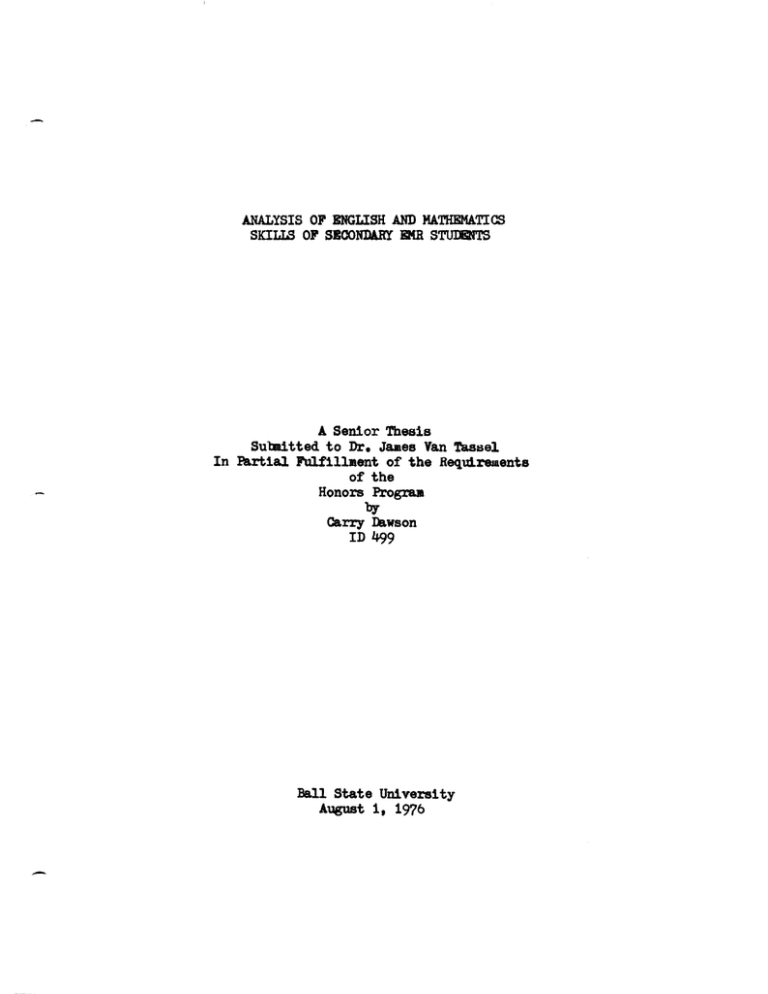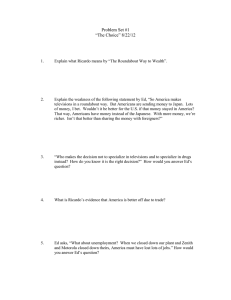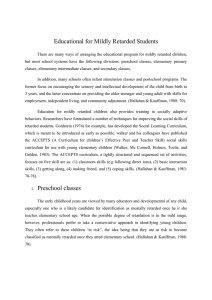499 Dr. Submitted to James Van
advertisement

ANALYSIS OF ENGLISH AND MATHEMATICS
SKILIB OP SECONDARY EMR STUlBNTS
A Senior Thesis
Submitted to Dr. James Van
~sel
In Partial J'u1f1llllent of the Requlrements
of the
Honors Program
by
Carry lawson
ID 499
Ball State University
August 1, 1976
",-'(." .,'
('
J:""
The current American Association on Mental Deficiency (AAMD) definition
of mental
re+~rdation
(Grossman, 1973) states.
Mental retardation refers to significantly su~verage general
intelle4::tual functioning existing concurrently With deficits
in adaptive behavior and manifested during the developaental
period. (p. 5)
In operationlu terms, this means an individual. 's measured. intelligence must
be at least two standard deviations below the mean (68/70 I .Q.). he must
have been idontified prior to the age of 18 and he must have been determined to be ttunable to meet the standards of personal independence and social
responsibility expected of his age and cultural group" (Brolin, 1975. p. 6).
It is unfortunate that this definition of mental retardation is not fully
accepted by the public.
The mentally retarded, according to Brolin, are one
of the least understood minority groupe in our country, and there are a
variety of misconceptions and negative opinions regarding both mental retardation as a c:ondition and characteristics of retarded individuals.
Research, in the field bas only perpetuated misconceptions by its lack
of specific d,escr1ptions, particularly in reference to the mildly retarded.
Brolin described this group which is often labeled "Educable Mentally
Retarded" (liJ.1R) as follows.
The m1ldly retarded range in IQ from 55 to 69 and comprise about
89% of the retarded population. Although many are retarded because
of minimal brain da.llage and other medical reasons (where the damage
is not severe), many others demonstrate no medical pathology and
are classified as cultural-familial. These individuals do not
have as :1IaJ1Y physical problems as a group and therefore are not •••
as distinguishably retarded as the other three groups of retardates.
They are generally able to develop fairly adequate social and
cOJUlunic:l.tion skills and a fourth to sixth grade academic level if
they rec,eive good educational services. (p. 8)
As a guide for providing educational services for DlR students,
Baumeister (cited in Brolin, 1975) listed the following learning cha.racteristics.
2
1.
The learning deficiencies of l!)1R persons are task specific or
related to only certain aspects of the learning situation.
2.
Under certain conditions their learning and retention are quite
adequate and comparable to normals.
).
Rote memory is often difficult to achieve.
4.
Meaningfulness of the material to be learned is important.
5.
Learning is facilitated if they are required to name the stimulus before responding.
6.
When verbU learning material is familiar and concrete, the
retarded do as well as normals.
7.
Overlearning materials apparently benefits the retention.
8.
Discrimination learning tasks are difficult compared to normal
persons.
9.
Previous experience in discrimination learning situations is an
important factor related to rate of learning.
10.
Prolonged failure experience affects abiUty to solve problems
formerly possible,
11.
They have a "generalized expectancy to fail" which is associated
With an unnecessarily low initial level of performance.
12.
Motor learning is most appropriate, and with proper training
methods the EMH indiVidual can learn many complex and intricate motor skills. (P. 15)
In similar fashion, Denny (cited in Brolin, 1975) described the learning
of EMR's as followsl
1.
As long as rote leaming materials are non-verl:al and familiar,
there is insufficient evidence of a learning deficit With the EHR.
2.
Direction following is a frequent problem requiring instructions
to be repeated frequently for learning to occur.
).
There may be an initial deficit on motor learning tasks, but
With practice they improve more rapidly than normals and sometimes catch up With them.
4.
As the difficulty of the task increases, the importance of
intelligence increases and despite faster improvement, they
are unable to make up the difference. (p. 15)
3
Research has provided a theoretical 'tackground and general guidelines
for teachers to use in establishing an »fR curriculum.
However, most specific
guidance has been provided for teachers of elementary-aged .liMR students.
Little direction is available for teachers of secondary »fR's in terms of
what 'tasic academic skills they can expect students to have when they enter
high school.
As a possible guide for beginning teachers, this paper will
examine academic skills of a ];articular secondary EMR class.
Setting
Students whose academic skills will be des crt bed were enrolled during
the 1975-76 school year in a high school EMR program located in a lower
socio-economic area of East Gary, Indiana.
The program is operated in accor-
dance with Indiana Department of Public Instruction rules and regulations.
Rule S-l, Revised (DPI, 1973) provides the following definition statementl
"Given an individual intelligence test such as the Stanford-Binet Intelligence
Test, the ed.ucable mentally retarded person will usually earn a quotient
within the 60-75 range" (p. 25).
Placement in the program was initiated
teacher referral and followed by testing and staffing.
~
Written parental
consent is required for both testing and Placement.
Although exact parental income data were not available, 13 of the 29
students in the program were eligible for the school's free lunch program
during the 1975-76 academic year.
Students ranged in chronological age from
13-6 to 20-2 years, with the mean at 16-5·Years.
IQ's ranged from 54 to tso
(mean 69), and mental ages ranged from 7.5 to 15 years (mean 11.2 years).
Subjects
A sample of seven students (5 male, 2 female) was selected for this
study.
These stUdents were assigned to the program during one class period
,-
which
each
facili1~ted
data collection.
Table 1 presents test data appearing in
student"s permanent record.
Table 1
Test Data Listed in Subjects' Permanent Records
Student
Date Tested
(CA at testing)
James
12-5-7
(15-9
Joan
5-14-75
5
Instruments & Results
WISC-R
Verbal-55, Performance-65,
Full Scale-56
WISC-R
Verbal-55, Performance-65,
Full Scale-56
Sight Voc. (3.5), Arith. (3.4)
(14-4)
WHAT
Joe
5-23-74
(16-6)
WArS
WHAT
John
3-25-75
(17-4)
WArS
WRAT
Luis
Luther
5-2-73
(17-1)
WArS
3-26-74
(15-8)
WISC-R
WHAT
WHAT
Toni
3-3-76
(14-8)
WISC-R
PIAT
Verbal-69, Performance-82,
Full Scale-73
Sight Voc. (2.8), Arith. (3.9)
Verbal-60, Performance-82,
Full Scale-69
Sight Voc. (5.4)
Verbal-63, Performance-82,
Full Scale-69
Sight Voc. (2.0), Arith. (3.4)
Verbal-55, Performance-87,
Full Scale-67
Sight Voc. (2.0), Arith. (4.4)
Verbal-55. Performance-63.
Full Scale-55
Math (2.6). Reading Rec. (3.4),
Reading Comp (2.9), Spelling (5.6)
Students' records include references to a variety of social data.
Three
students come from broken homes, two are described as "hated by their father,"
one has been in trouble with the pollce, one was allegedly raped by her
father, one 'boy's parents have lower IQ's than he, and one is an unwed father.
On the l::asis of these data, it was concluded that this sample of seven
students is
J~epresentative
of the range of academic skills and other factors
likely to be encountered in the "typical" high school EMR classroom.
Achievement Data
Data for this J;8per were collected over an eight week period.
Due to
students' faJu1iarity with and lack of enthusiasm for standardized tests, it
was decided that this method of gathering data
MaS
inappropriate.
Use of one
classroom as a sample allowed for collection of data in an unobtrusive manner.
Thus, rtoutine seatwork assignments as well as oral samples of students'
wom were compiled from all class periods in which anyone of the seven students in the sample was enrolled (ht)story, math, English, health, and science).
By virtue of this method of collection, consistency from one student to
another is not always possible, and comJ;8risons are difficult.
English
This area. encomJ;8sses many skills needed for success in other academic
areas.
This is the reason for its analysis. broken down into three areas I
oral reading skills, reading comprehension, and spontaneous written language.
Oral Reading Skills I
Samples of the students' oral reading skills were
tape recorded during several reading lessons, and later transcribed.
analyzing these tapes, several common problems became obvious.
was pil.id to 'word endings (i.e., looked for looking,
lights).
h.!
In
.
Little heed
for he's, light for
Rlonics and word attack sk111s, if used at all, were usually limited
to the i'irst letter of the word (i.e.,
~
for
!!:!ill., .1?1.B! for bubbled,
grOUP
for &!X.), and at those times when no attempt was made, the student pil.used
and waited f.)r assistance from either the teacher or another student.
Although
b
sight vocabulary tended to be relatively good, mistakes were often made on
pre-primer or primer level words (i.e., !!!.£! for~, of for i2., !!§§. for ~).
Repetition of words was also a common error.
Only one of the students cor-
rected his own errors, and at the other end of the spectrum, two students
continued reading, even if, due to their errors, the selection made no sense.
Another student had a tendency to insert words
~
(~!!'!!!!
J!:2
~
for
~
with) as well as disregarding vowels (~for drew, &y!. for e!!.).
Following is an excerpt from the text I
The lancho Villa Rebels, by
Mary W. SulUvan, Field Educational Publications, Inc., 1970.
"Not quite," Ricardo said bitterly. "Connie Hidalgo doesn't
waste her time helping people. This !Brty was for one person, and one
person only. Connie Hidalgol Just a neat trick to get Tim Smith
over here."
Consuela cried, "I told youl I told you that night I wanted to
show him!"
"Show him what?" Ricardo stormed. "Show him how mean Connie can
be to a fine old lady? I should have knownl You didn't even want
us to play 'Ma.nanitas' at your own grandmother's IBrtyl" Ricardo
shook h:Ls head and went on. "And now you show Tim that good guys
like laco and Miguel fill Connie with shame. So what if their English
isn't all it should be? You know other things are important, don' you?"
Rit::a.rdo had said don' instead of don't.
"Not don' you - don't youl" Consuela almost spit out the t on
don't. Then she was sorry. She tried to explain. "It hurts laco
and Miguel. It hurts you if you don't speak right! If I wasn't so
mad, I wouldn't tell you again. But you'll never get out of here if -"Well," Ricardo put in. "If I wasn't so mad, I wouldn't tell
you this. Even if I get a job at Disneyland, I'm going to college.
I don't care if' it takes me fifty years. But I'm not going to do it
by turnlng my 'tack on my family. Or my friends - however they talkl"
This excerpt was read as follows.
The asterisks indicate !Buses made
by the student, usually where words were given to him, either by the teacher
or another student.
"Not quite," Ricardo said * bitterly bltterly. "Connie Hidalgo
doesn't wasn't * waste her time helping people. This !Brty was for
one person and one person only. Consuela Ricar-Hidalgo. Just a net
* neat * trick to get Tim Smith over here."
7
Consuela crawl cried, HI thought I took * I told you I told
you tha-l:. that * night I wanted to show him."
"Show him * what?" * Ricardo * stormed. "Show show me now *
show me how now * show him how now * show him how mean Consuela can
be to a friend older * fine * old lady. I should have knownl You
didn't ,even want us to play * 'Ma.nan1tas' at your own grandmother
pu-ty."
Consuela I mean Ricardo stood shook his hand and went on and
* head Sonsue1a (skipped line) "And now you should * now you show
Tim tha"1; good guys like laco and Jua.n1 * Miguel fill Consuela *
Connie "nth * shame. So that is * what if that * their English
isn't all it * should be. You know other things are important,
don • t y,:>u?"
Ri·cardo had said don't * don instead of don't. "Now don *
not don you, don't youl" Con-Consuela almost * split * spit out
the * the t on don't. Then she was sorry. She tried to explain
to harker * hurt lapo and * laco and Midge * Miguel. It hurt you
if you 'fidn't speak right. If I wasn't so mad I would wouldn't
tell you again, but you'll never get out of * here if you'll *
"Well," Ricar-Ricardo * put in, "If I wasn't so mad I would tell
you * this never * even if I got a job at Disneywor1d, lim goint
to * college. I'll do I didn't * I don't care if it takes me *
fifty years, but I'm going * but I'm not going to do it my * qy
trying * turning my lack on my friends * family on my friends now
* however they talk."
Reading Comprehension.
Measured qy various types of questions, com-
prehension is vital in many academic areas in order to progress.
of questions were a.na.lyzed for the purpose of this plperl
and
!!!l questlons.
Two types
yes/no questions
Questions in the sample were constructed qy the teacher,
and in all ca.ses, students were allowed to refer to the text for assistance.
Although this is not an advisable procedure for evaluation, in this case
it aides in ,ar.am&tizing the problems these students have.
For the yes/no questions, given over four chapters, accuracy ranged
from 100}& to 3~, with a mean ot· 65 •.5%.
Of these 40 questions (10 per
chapter), approximately hal:£' of them had answers directly stated in the text
(i.e., "Was the old. house all lit up?"
all lit up.").
The text states.
"The old house is
The other half of the questions require some degree of
inference on the J;S.rt of the pupils {i.e., "Did people say the Pool was
8
always ice cl)ld?"
Of the 19
to·~al
The text states I
"People said that the Pool never froze.").
direct questions, 10 were answered correctly by all students.
On the remai:ning nine questions, a range of one to six students had incorrect
resp:mses.
.only 1/3 (7 out of 21) of the questions whose answa were in-
directly stated received correct respmses from all students.
There was a
range of from one to six students with incorrect resp:>nses on the remaining
14 questions.
!h
questions (that is, questions beginning with
!!h2., !!!:!!i, where, etc.)
require the student to answer in a :Ittrase, or something other than choosing
between g1 VE!l1 responses.
These questions also included answers directly or
indkectly stated in the text.
100% to 0% with a mean of
Accuracy range for the wh questions was from
74.~.
Of the 40 questions, 22 had answers which
were directly stated, and 15 were answered correctly by all stUdents.
The
remaining seven_bad incorDect responses from a range of one to three stUdents.
In the group of
1~
questions with indirectly stated answers, eight were
answered correctly by all students, and in the remaining 10, there was a range
of one to SEwen students with incorrect answers.
Respon~~es
for these questions varied from incomprehensible (i.e., "What
did the Piper's head look like?" "the I did the") to misreading the question
("What did 11a. Lovey say to prove Michael's parents loved him?" "She took him
in her arms.") to simply incorrect ("Who did Michael have a fight with?"
"Lennie.") •
Spontaneous written la.ngua.gel
Samples for this area were taken from all
assignments which required a written response from the students (such as
creative wrtting, and workbook exercises).
four of the seven students.
Samples were available for only
They were assEted with spelling, if and only if,
9
they requested it.
However, this was the only form of assistance they received.
This section has been divided into four area.s.
spelling, grammar, punctuation,
and capitalization.
All foux' of the students exhibited spelling problems, especially with
homonyms (i.e., threw for through, their for there), word endings (i.e., cOmmipg
for coming, leggs for
!!s!.),
as well as non-phonetic words (i.e., juce for juice).
In terms of grammar errors, two of the students exhibited problems in
verb tenses (i.e., £2!! for 2!!!), person (i.e., don't for doesn't), and
use of negatives (i.e., !!.2. for any).
One of these two has problems so severe
that statements were unintelligible.
The other two students did not demon-
strate any problems here.
Periods were the only ptmctuation mark used universally, while apostrophes, quotation marks, and commas were seldom used, and not always appropri-
-
ately.
In only one of the four cases was there a problem with capitalization,
and it involved using capital letters either inappropriately or not using
them when necessary.
FolloWing are samples of two students' Writing.
This assignment asked
students to write an ending to the story Upward Toward Hope by Chuck Munar,
a story about two young teenagers who had a motorcycle accident in the desert
and are now both hurt ladly.
I. Eddil~ was dran so must to could hold his head up. He want to the
motmtain and fell of the motorcycle and Dead. His girlfriend want to
the hous4~ and was cry so mush so she could stop cry. I sleep so mush
and he c()uld see know one. He want to the hospital in the ambulance.
II. suddenly more and more Vultures came suddenly I noticed that they
were not after me so I slowly crawled down the hill lack threw the
bushes and finally I saw eddy tmder a rock with his leg pinned under
it I Knelr if I didn't find water in a little while that I would be done
10
for so I started to look for some I didnt find water but I found a
small cactus I used my hard sole of my shoe and began pounding on
it finally it split open I saw some Juce comming from it.
Summary I
Difficulties encountered by these students in English skills
demonstra.teprorable cause for a great many other academic problems that
they have.
'l'ypes of errors made in oral reading most assuredly contribute
to comprehension problems, as the errors usually changed the meaning of the
statement.
Without more extensive use of phonics and word attack skills,
very little progress in their reading ability can be expected.
Inability
to use context clues, and, therefore, continuing with the passage in spite
of the illogical nature it may begin to demonstrate, also impairs further
growth.
In reviewing the analysis of students' comprehension skills, it appears
that students have greater difficulty on inference-type yes/no questions
than factual-direct yes/no questions.
However, the fact that these ques-
tions allow the student a 50-50 chance of being correct must be kept in mind.
Since only 17 out of 40, not quite 50% of the questions were answered correctly,
it is difficult to conclude that the students comprehended what was read,
in spite of the opportunity to refer rack to the text.
~
questions, however, produce a more marked difference between questions
with directly stated and indirectly stated answers.
Almost 75% of the ques-
tions with directly stated answers received accurate responses, while not
quite
50%
of' those questions with indirectly stated answers were correctly
responded to.
One may infer with some degree of confidence that compre-
hension is d.esperately in need of attention, especially the realm of inference,
-
in response to either type of questions.
11
Areas d1scussed in conjunction with spontaneous written language indicated problems one might expect to find, having observed the students' oral
reading problems.
The spelling problems conceming word endings is predic-
table, as the students tended to ignore these in oral reading.
Not examining
the entire W()rd contributes in some degree to many of the grammar errors, as
the students have presumably not noticed. the ,differences between the words.
The inappropriate usage of both punctuation and capitallzation would tend to
indicate
tha1~
the students have been oblivious to them also.
Another factor
to be considored. is that many of these students speak non-standard English,
which not only complicates their written communication, but also their ability
to comprehencl reading material and. questions.
Mathematics
Basic rna.thematic skills are essential to everyday living - one must know
how to make Ellementary business transactions.
selected. for analysis.
Due to its importance, it was
The f'act that the math class was divided. into groups
complicated c:onsistency between students to a greater degree than was evident in the Elnglish section.
However, J8tterns which indicate problem areas
are evident.
This segment has been divided into the two 'tasic areas of
mathematics I
1) addition and subtraction, and 2) multiplication and division.
Addition and Subtraction I
In examination of the addition exercises done
by the students, the most outstanding problem was that of carelessness.
Two
studEl'lts, however, , demonstrated. the pro'tability of inadequate knowledge of
their addition facts.
(See Example 1.)
Carrying did not appear to present
a problem, nor did the size of the number involved (up to three tlve digit
numbers were completed accurately With carrying).
Example 11
65900
3782
6t3tlZO
137852
14
other.
Sinc'9 the secondary level 1:asically reviews skills previously intro-
duced, the st.udents feel that they have already acquired them, although this
,-
paper illust:rates that they have not.
One can easily perceive the type of
motivation problem the teacher is confronting.
A combination of creativity
and practicality can be utilized to raise the motivational level, by discovering new and exciting ways to apply these skills in realistic situations,
so that the students may begin to grasp the value of possessing them.
This paper has also illustrated the extreme and unpredictable variance
in students' abilities from one subject area to another.
Thus the beginning
teacher faces the puzzle of at least a lIinimum of group activities (keeping
the develoIJllent of social skills in mind) which students of such varying
skill levels can enjoy and profit from, as well as individualizing instruction
effectively in terms of the students as well as him/herself.
Summary
This IBper has examined 'tasic English and mathematic skills of seven high
school Et-fR students, taken from a large group of 29, from a low socio-economic
area of East Gary, Indiana.
Data were informally collected from routine
assignments, and analyses of the skills also incorporated suggestions for com'tatting some of the deficiencies.
main areas I
English skills were broken down into three
oral reading skills, reading comprehension, and spontaneous wr1 t-
ten la.ngua.ge; and mathematics was broken down into tWOI
tion, and multiplication and division.
addition and subtrac-
Each area was examined seIBrate1y.
References
Brolin, D.
Vocational Pre'f,!r!tion of Retarded Citizens.
Columbus.
Merr1ll, 1976.
Grossman, H. (Ed.) Manual on Terminology and Classification in Mental Retardation.
Wasningtona American Association on Mental Deficiency, 1973.
Rule S-l Revised.
Indianapolis I
Department of Public Instruction, 1973.
12
Subtrac·~ion,
however, proved to be a more difficult computation.
Three
of the four :students whose work was analyzed indicated definite problems in
borrowing, especially subtraction from zero.
(See Example 2.)
One of the
students exhlbited an inability to determine the appropriate times to borrow
(see Example 3) and two indicated a lack of knowledge of subtraction facts
(see Example 4).
Example 21
$
- 9Z8
MultipUcation and Division.
~i.bili ty
Example 4.
2"jy/
a...,~
...••
- 15~6
28 4
- 1095
12613
zze
variance in
\."
Example 3.
1~40
f.lultiplicatiOJ1i problems yielded more
than any of the other areas being discussed.
Only one
of the five Istudents could do three digit x two digit problems involving
addition and carrying without difficulty.
Two students appeared to understand
the procedurta for this type of problem, but because they did not know all
their multiplication facts, they had great difficulty with them.
lem
"HaS
shartad with the other stUdents.
of two students
Example
"HaS
(See Example
This prob-
5.) Another problem
an ap];arent inability to recall numbers carried (See
6). Multiplication
one student (see Example Z).
Qy zero
"HaS
definitely not fully understood qy
Multiplication of any number times two digits
was beyond the level of two students, at that time tsee Example ~).
Example 51
122
Example 6.
:(42
~
2l:)ts
"3134
15
x~
490
Example 71
305
Example
~
120
195U
12~U
3525
456Z
x
29
40603
15Z5
Division problems were contributed Qy four of the students.
Two of them
appeared to know their division facts well, and could do long division and
short division with remainders.
~I
However, the other two seemed to be laCking
13
in both areas.
(See Examples 9 and 10)
d tl
Swnmary:
discussion.
6
Example 10 I
23)2093
Example 91
The importance of addition and subtraction hardly requires
In seatwork assignments as these were,
J
the students completed
addition exercises adequately, although carelessness was an occasional prob1em.
Subtraction was another matter.
concept of
~~ce
More time needs to be spent on the
value and borrowing for the students to develop proficiency.
Multiplication, in all cases but one, was grasped at the very l::a.sic level,
and Will require more effort for a fuller understanding at the complex level
of multiplying by two digits.
All of the students could benefit from more
extensive drill on multip1iCRtion facts.
Although speed was not assessed,
it is recalled that this area was also deficient.
In spite of the fact that
insufficient evidence 'Was accumulated to make a definitive statement on
division skills, more time should be spent on drill and the con::epts of remaindars and long division.
This l«>uld greatly benefit the students in increased
speed and accompl,nying accuracy, as well as lend to the understanding of those
students still vague on the procedures.
Transfe:r of these skills to more practical situations (story problems)
was not dete,rmined.
This opens up an entirely new group abilities, which,
by definition, will encompass the English skills already discussed as well
as the mathematic skills.
The value of pl,iring these sets of skills for prac-
tical application cannot be emphasized enough.
Discussion
Numerou.s considerations must be made by the beginning teacher.
Moti-
vation is indescril::a.b1y important, perhaps more so at this level than any







